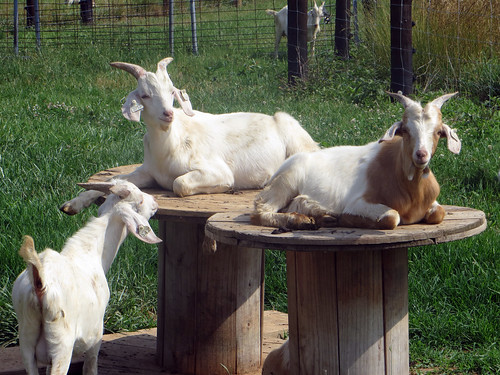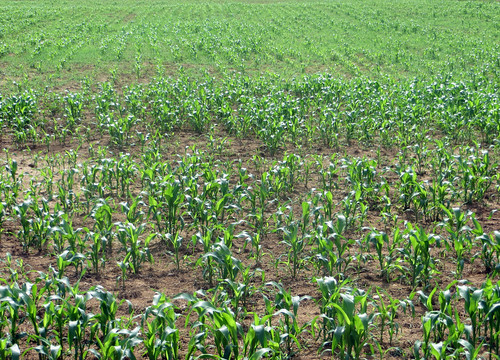Fourteen days into the test, twenty-five bucks were dewormed with levamisole (Prohibit @ 1.5x the sheep dose). Fifteen required deworming, as they had FAMACHA scores of 4 or 5. An additional ten bucks with FAMACHA scores of 3 were dewormed.
Not all goats with FAMACHA scores of 3 were dewormed.The decision to deworm a goat with a FAMACHA score of 3 is based on numerous other factors, such as weight gain, body condition, coat condition, and dag score. The standard recommendation for the FAMACHA system is to deworm kid goats with FAMACHA scores of 3, 4, and 5. The test has not found it necessary to always deworm goats with FAMACHA scores of 3.
Goats with FAMACHA scores of 5 were put into the treatment pen for observation. Many goats respond well to deworming, whereas others may require supportive therapy. More than half of the study goats in the pasture group also required deworming, as their FAMACHA scores averaged almost 4 (3.7).
FAMACHA scores dropped almost one full score in 14 days. On June 27, FAMACHA scores ranged from 1 to 5 and averaged 2.6 + 0.9, compared to 1.8 on both May 31 and June 13. The median FAMACHA score on June 27 was 3.
Scours
Body condition and coat condition scores remained relatively unchanged. However, 24 goats had positive dag scores. Dag scores ranged from 0 to 5 and averaged 0.5 + 1.0. Dag scores (0-5) are a measure of fecal soiling and an indication of scours (diarrhea). Scours in the test goats is usually self-limiting and the result of diet or stress.
If a fecal sample cannot be obtained from a goat, it is put back into the handling system and a second attempt is made to collect a sample. It is very difficult to obtain a fecal sample from a goat with liquid feces, e.g. fecal consistency score = 1 and dag scores > 3. For this reason, some goats will not have fecal egg counts for June 27.
Fecal egg counts
Having so many goats anemic, so early in the test was unexpected, as the goats had low egg counts upon arrival to the test site on May 31. Fecal egg counts were even lower on June 13, after the triple dosing with moxidectin (Cydectin), levamisole (Prohibit), and albendazole (Valbazen).
For the fecal samples collected on June 13, fecal egg counts ranged from 0 to 6,533 epg. However, only one goat had a high fecal egg count, and 55 goats had negative fecal tests (fecal egg count = 0). If the one high egg count is discarded, fecal egg counts averaged 59 + 184 epg. The median egg count was 0.
For the goats that had positive egg counts on May 31, their fecal egg counts were reduced an average of 83 percent, as a result of the triple deworming. The median fecal egg count reduction was 100 percent.
The sheep that grazed the test site prior to the arrival of the goats must have done a good job contaminating the pastures with worm eggs, as this is the earliest the test goats have ever been challenged by parasites -- 28 days after the initial anthelmintic treatments. Recent weather conditions (warm + moist) have also been favorable for worm development.
In a couple of weeks, the four acres of dwarf sorghum should be ready for grazing. This will give the goats some relief from parasites, as it will be a clean pasture and sorghum is a taller-growing forage than the cool season grasses the goats are currently grazing.
Having to deworm so many goats may be disappointing to some consigners, but having a significant parasite challenge is the only way to identify those bucks which are resistant and/or resilient to internal parasites. While almost 31 percent of the goats required deworming, 69 percent did not. Forty-six percent of the bucks had FAMACHA scores of 1 or 2 (non-anemic).
Goats gain almost 2 pounds
For the first 14 days of the test, gain ranged from -5.2 to 4.1 lbs. and averaged 1.4 + 1.9 lbs. The median gain was 1.7 lbs. Average daily gained ranged from -0.371 to 0.293 lbs. per day and averaged 0.098 + 0.137 lbs. per day (44 + 62 g/d). The median average daily gain was 0.121 lb/day (55 g/d).
For the first weigh period, the top gaining goats were #323 (Burke), #350 (Peters), #351 (Pinneo), and #375 (Weber). The Weber goat was the top-gainer for the period. Several consigners had consignments with all positive weight gainers.
Download June 27 (d-14) report
Not all goats with FAMACHA scores of 3 were dewormed.The decision to deworm a goat with a FAMACHA score of 3 is based on numerous other factors, such as weight gain, body condition, coat condition, and dag score. The standard recommendation for the FAMACHA system is to deworm kid goats with FAMACHA scores of 3, 4, and 5. The test has not found it necessary to always deworm goats with FAMACHA scores of 3.
Goats with FAMACHA scores of 5 were put into the treatment pen for observation. Many goats respond well to deworming, whereas others may require supportive therapy. More than half of the study goats in the pasture group also required deworming, as their FAMACHA scores averaged almost 4 (3.7).
FAMACHA scores dropped almost one full score in 14 days. On June 27, FAMACHA scores ranged from 1 to 5 and averaged 2.6 + 0.9, compared to 1.8 on both May 31 and June 13. The median FAMACHA score on June 27 was 3.
Scours
Body condition and coat condition scores remained relatively unchanged. However, 24 goats had positive dag scores. Dag scores ranged from 0 to 5 and averaged 0.5 + 1.0. Dag scores (0-5) are a measure of fecal soiling and an indication of scours (diarrhea). Scours in the test goats is usually self-limiting and the result of diet or stress.
If a fecal sample cannot be obtained from a goat, it is put back into the handling system and a second attempt is made to collect a sample. It is very difficult to obtain a fecal sample from a goat with liquid feces, e.g. fecal consistency score = 1 and dag scores > 3. For this reason, some goats will not have fecal egg counts for June 27.
 |
| The goats relaxing after handling. |
Fecal egg counts
Having so many goats anemic, so early in the test was unexpected, as the goats had low egg counts upon arrival to the test site on May 31. Fecal egg counts were even lower on June 13, after the triple dosing with moxidectin (Cydectin), levamisole (Prohibit), and albendazole (Valbazen).
For the fecal samples collected on June 13, fecal egg counts ranged from 0 to 6,533 epg. However, only one goat had a high fecal egg count, and 55 goats had negative fecal tests (fecal egg count = 0). If the one high egg count is discarded, fecal egg counts averaged 59 + 184 epg. The median egg count was 0.
For the goats that had positive egg counts on May 31, their fecal egg counts were reduced an average of 83 percent, as a result of the triple deworming. The median fecal egg count reduction was 100 percent.
The sheep that grazed the test site prior to the arrival of the goats must have done a good job contaminating the pastures with worm eggs, as this is the earliest the test goats have ever been challenged by parasites -- 28 days after the initial anthelmintic treatments. Recent weather conditions (warm + moist) have also been favorable for worm development.
In a couple of weeks, the four acres of dwarf sorghum should be ready for grazing. This will give the goats some relief from parasites, as it will be a clean pasture and sorghum is a taller-growing forage than the cool season grasses the goats are currently grazing.
 |
| Dwarf sorghum |
Having to deworm so many goats may be disappointing to some consigners, but having a significant parasite challenge is the only way to identify those bucks which are resistant and/or resilient to internal parasites. While almost 31 percent of the goats required deworming, 69 percent did not. Forty-six percent of the bucks had FAMACHA scores of 1 or 2 (non-anemic).
Goats gain almost 2 pounds
For the first 14 days of the test, gain ranged from -5.2 to 4.1 lbs. and averaged 1.4 + 1.9 lbs. The median gain was 1.7 lbs. Average daily gained ranged from -0.371 to 0.293 lbs. per day and averaged 0.098 + 0.137 lbs. per day (44 + 62 g/d). The median average daily gain was 0.121 lb/day (55 g/d).
For the first weigh period, the top gaining goats were #323 (Burke), #350 (Peters), #351 (Pinneo), and #375 (Weber). The Weber goat was the top-gainer for the period. Several consigners had consignments with all positive weight gainers.
Download June 27 (d-14) report












